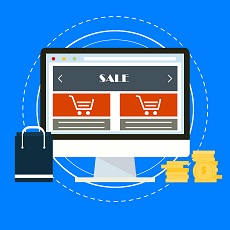
What if we told you that you have the potential to know what your customers want before they even realize it? Imagine how sending the right products at the right time could improve your email conversion rates.
Well, with the help of predictive product recommendations, this can become a reality in your email marketing. By using this predictive, data-driven tactic, you can provide your customers with a more personalized experience while limiting the manual lift on your teams.
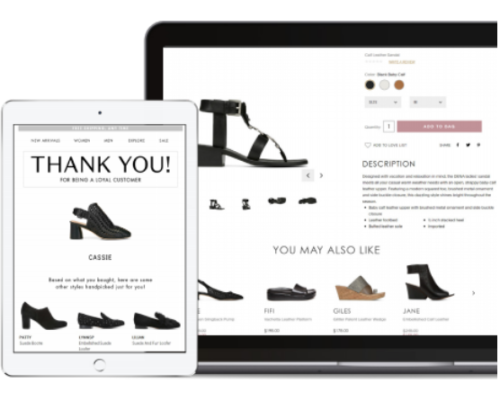
Not only can predictive product recommendations help sell more products after initial purchase, such as the tablet example above, it also can be used while customers browse. Having the opportunity to share more products that the customer might be interested in will help intrigue the customer to add more items to their cart. Image courtesy of Listrak.
Personalizing your email communications can help increase your transactional rates by six times compared to your non-personalized emails. This means that taking the time to understand your customers and provide them with personalized product recommendations, you’ll be able to directly increase sales related to email marketing.
Here’s a quick overview of what we’ll discuss in this article:
- Detail what predictive product recommendations are and how they can help your email marketing
- How upselling and cross-selling mixed with predictive product recommendations can increase sales
- Lots of examples of product recommendation emails
- Best practices to get your product recommendation emails started
Breaking Down Predictive Product Recommendations
You now have the ability to understand your customers on a deeper level than ever before. Having a better understanding of the purchase behavior of your customers, you can predict and recommend new products that they may be interested in.
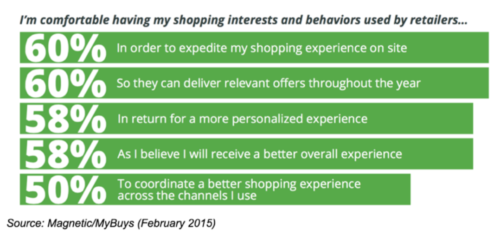
Shoppers are comfortable providing their shopping behaviors with retailers if they use it in the proper ways. Some of these top reasons include expediting the shopping experience and increasing personalization and relevant offers — all things that predictive product recommendations provide your customers. Image courtesy of Business2Community.
These product recommendations are backed by machine learning technology and allows you to provide your customers with the most relevant products. The reason predictive product recommendations work? Because they are data-driven and use the previous interactions your customers have already taken to formulate new products to share.
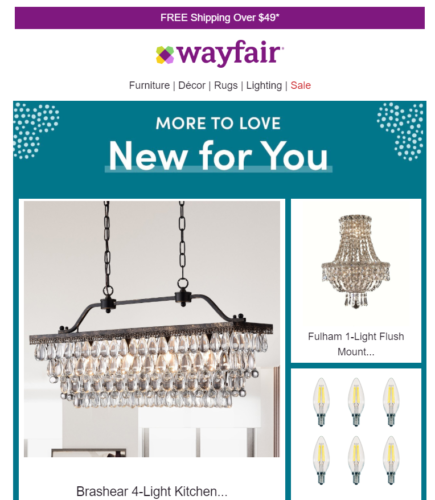
Knowing what customers are shopping for and providing them with recommended products can help move them along in the sales cycle. Maybe the first item they looked at didn’t land the sale, but you can send them some additional options to consider while they are looking around. Image courtesy of Wayfair Marketing.
It’s possible to breakdown your predictive product algorithm to meet your goals. Here are a few different options you have when it comes to predictive modeling:
- Recently purchased
- Recently viewed
- Items frequently bought together
- Best-sellers
- New trends and top rated
- New arrivals
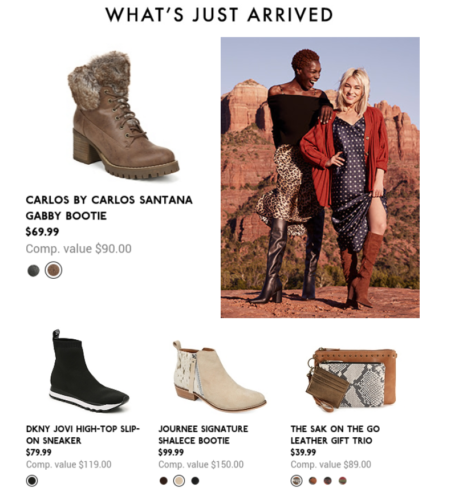
This email from DSW takes advantage of the new arrivals to share recommended products to customers. Sending this email will bring shoppers looking for new shoes to the site, and will land them in the section of shoes they most frequently visit. The great thing about these emails, they can tweak the content dependant of the seasons or trending styles as well. Image courtesy of DSW Marketing.
Let’s take a look at how you can use predictive product recommendations in your email marketing can help increase sales and provide customers with a personalized experience.
Using Predictive Product Recommendations to Increase Sales
There are a few different ways that you can use predictive recommendations in your emails. But predictive recommendations can go beyond just knowing what brands and price points your customers frequently purchase at. It can also be an opportunity to implement cross-selling and upselling tactics.
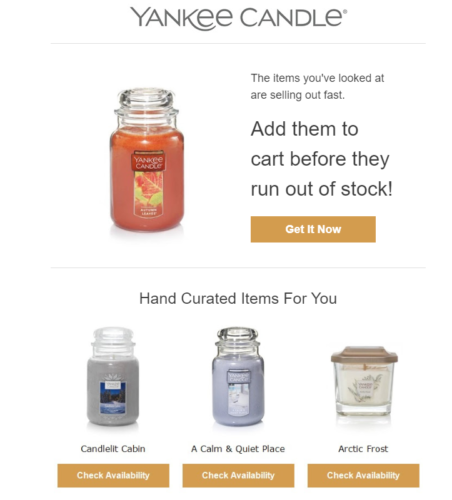
This example not only reminds the shopper of an item they looked at, but it also provides product recommendations by providing hand-curated items to try and upsell the products. The consumer may decide to add the original item to their cart and one of the other suggested items. Image courtesy of Yankee Candle Marketing.
Amazon is a great example of how this can work in practice, and be hugely successful. 35% of Amazon’s revenue is generated by its product recommendation strategy. That’s a huge amount of sales attributed directly to recommendations and shows how important it is to send personalized follow-up emails to customers.
Consider this example to understand how cross-selling and upselling product recommendations can improve your sales.
A customer purchases a new video game system. After they have made the purchase, the company may send them a follow-up email promoting video games, extra controllers, or headsets. The customer may not have even realized they needed these extra parts and pieces, but you’ve reminded them and may land a sale due to it. Now you’ve solved a problem for your customer and sold them another item.

Although a little different scenario, the products shown at the bottom of this email provide customers with a predictive product recommendation based on the products they are shopping. Using this user’s shopping behavior, it’s very likely that they may be interested in some of these other items and add them to their cart. Image courtesy of Baymard Institute.
Predictive Product Recommendations Best Practices
Knowing what your customers want and when to send it to them can seem like an intimidating task. But by working with the right partner and knowing where to start can make it a lot easier. Let’s take a look at a few best practices to help get you started with what you already have in the world of product recommendations.
Use Current Customer Shopping Data
Even if you don’t have the most advanced data tracking, you can determine what products your customers are purchasing and identify trends within that data. By leveraging this data, you can get started forming conclusions on what your customers want to see from your company.
From there, it’s time to start segmenting your customers. Group like shoppers together and start marketing to them with relevant content that they would be interested in. This helps make the task of personalization a little less daunting for you and still provides them with a personal touch.
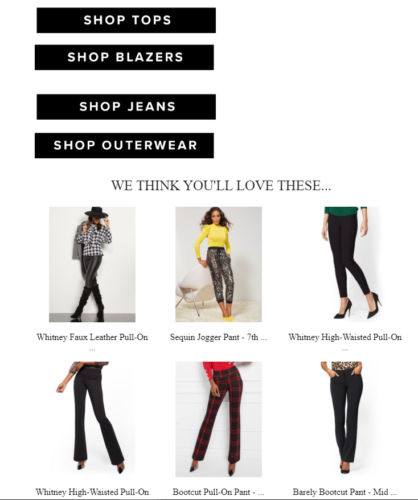
This example from New York & Company shares a variety of pants based on shopper behavior. Knowing that the customer purchased a new pair of dress pants recently, they are taking a good guess that they may be in the market for more if something catches their eye. Image courtesy of New York & Company Marketing.
Leverage Frequently Purchased Together Recommendations
If you can identify products that are often purchased together, why not share this with your customers? It’s very likely that if a large group of people is already purchasing these items together, others would do the same. Start sharing like items and you’ll see an increase in sales. This is another simple way to get your feet wet in the world of product recommendations.
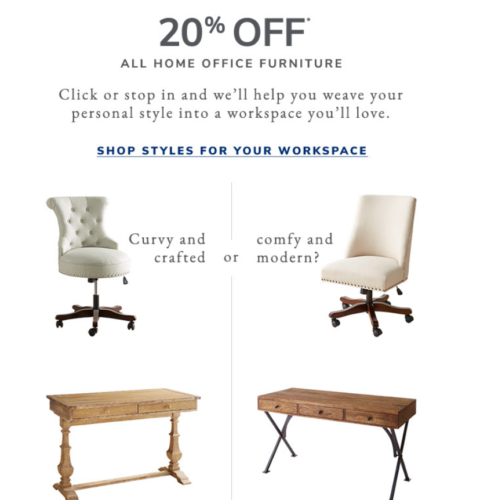
Pier1 knows that its customers are often looking to remodel an entire room when they are shopping. This email promotes products that can be used throughout an office space, not just one piece over another. The great thing about this promotion is it helps a customer visualize some of these pieces together so they don’t have to even think about it — a great way to share recommended products. Image courtesy of Pier1 Marketing.
Recommend Your Best-Selling Products
Another simple way to start recommending products to your customers (after you’ve segmented your list) is to recommend your best-selling products. This should be a simple report that you can pull and analyze to determine which products are bringing in the most sales.
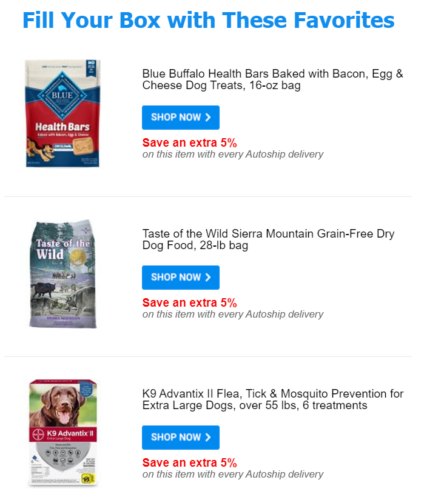
Chewy does a great job of providing product recommendations in their emails. This example shares some customer favorites across the board, from dog food to flea and tick medicine. If a customer were looking for a new product, this email would likely help sway them towards some of the more popular items. Image courtesy of Chewy Marketing.
From there, you can share these products with your email subscribers based on their shopping behavior and interests. The more relevant they are to their personal experience, the more likely they are to add those products to their cart and complete the purchase.
Start Recommending Products and Increasing Sales
While these are only a few best practices to get you started, predictive product recommendations can continue to be built upon. Once you’ve got your feet on the ground, you can eventually move your recommendations into a more advanced system that will allow you to actively analyze customer data and improve recommendations as you learn more about your customer’s behaviors.
No matter where you fall currently in the process of predictive product analytics, you can always improve your process and increase sales at the same time. So what are you waiting for?
Related posts:






